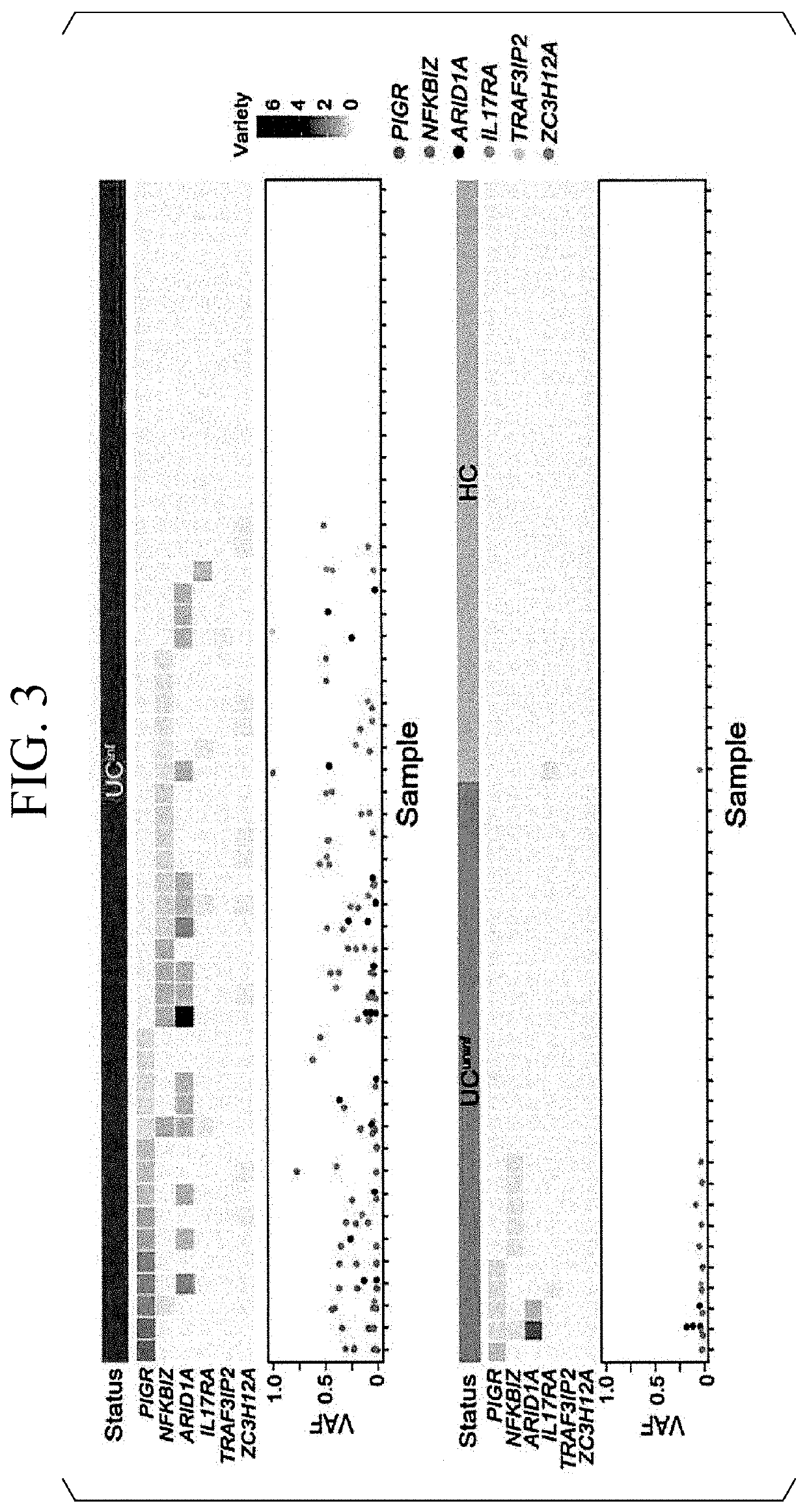Method and kit for detecting risk of colorectal cancer
a colorectal cancer and kit technology, applied in the field of colorectal cancer risk detection kits, can solve the problems of not knowing the reliable marker that can detect the risk of cancer in patients, and the known high risk of cancer of patients with ulcerative colitis
- Summary
- Abstract
- Description
- Claims
- Application Information
AI Technical Summary
Benefits of technology
Problems solved by technology
Method used
Image
Examples
experimental example 1
[0060](Preparation of Organoid)
[0061]The experiment was carried out based on the approval of the Keio University School of Medicine Ethics Committee (approval numbers 20120057, 20130512, and G3553-(7)). Intestinal tissue samples were collected from patients with ulcerative colitis who received informed consent and underwent colonoscopy or surgery.
[0062]In a case of an intestinal tissue sample derived from a healthy subject, the stromal tissue was removed from the intestinal tissue, and the epithelial tissue was cut to a size of about 1 mm3. Epithelial tissue fragments were washed at least 5 times with phosphate buffered saline (PBS) ice-cooled. Subsequently, intestinal crypts were released by treatment at 4° C. for 1 hour while gently stirring in 2.5 mM EDTA.
[0063]Subsequently, the released intestinal crypts were suspended in Matrigel (registered trade name, BD Biosciences), and aliquots of 25 μL as a droplet were seeded on a 48-well plate. After the Matrigel got gelled, a medium ha...
experimental example 2
[0068](Examination 1 of Loss-of-Function Mutation of Gene Involved in IL-17 Signaling)
[0069]Whole exome sequencing of each organoid clone established in Experimental Example 1 was carried out to examine whether gene mutations specific to the UCinf organoid were accumulated or not. The inventors focused on the truncating mutations (the short type mutations) including a nonsense mutation, a frameshift mutation, and a mutation at a splicing site, which may cause a loss-of-function mutation.
[0070]FIG. 1 is a diagram showing the analysis results. In FIG. 1, the horizontal axis indicates the clone name of each organoid clone. In addition, “UCinf” indicates a case of being a UCinf organoid, “UCuninf” indicates a case of being a UCuninf organoid, and “HC” indicates a case of being an HC organoid. In addition, in “CAN”, a black square indicates that a patient with ulcerative colitis has a colitis-associated tumor. In addition, “Truncating” indicates a truncating mutation.
[0071]In addition, “...
experimental example 3
[0080](Examination 2 of Loss-of-Function Mutation of Gene Involved in IL-17 Signaling)
[0081]In Experimental Example 2, the accumulation of truncating mutations was examined using an organoid clone. In the present Experimental Example, genomic DNA was extracted from a UCinf organoid, a UCuninf organoid, and an HC organoid, which were polyclonal and had been cultured in less than 4 passages, and target genes were sequenced to examine the accumulation of truncating mutations. As the target genes, 37 genes including genes involved in IL-17 signaling and driver genes for sporadic colorectal cancer were examined.
[0082]FIG. 3 is a diagram showing the analysis results. In FIG. 3, the horizontal axis indicates the results of experiments carried out independently. In addition, “UCinf” indicates a case of being a UCinf organoid, “UCuninf” indicates a case of being a UCuninf organoid, and “HC” indicates a case of being an HC organoid.
[0083]In addition, “PIGR” indicates the PIGR gene, “NFKBIZ” i...
PUM
| Property | Measurement | Unit |
|---|---|---|
| physical | aaaaa | aaaaa |
| size | aaaaa | aaaaa |
| composition | aaaaa | aaaaa |
Abstract
Description
Claims
Application Information
 Login to View More
Login to View More - R&D
- Intellectual Property
- Life Sciences
- Materials
- Tech Scout
- Unparalleled Data Quality
- Higher Quality Content
- 60% Fewer Hallucinations
Browse by: Latest US Patents, China's latest patents, Technical Efficacy Thesaurus, Application Domain, Technology Topic, Popular Technical Reports.
© 2025 PatSnap. All rights reserved.Legal|Privacy policy|Modern Slavery Act Transparency Statement|Sitemap|About US| Contact US: help@patsnap.com



